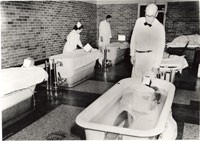In a 40-year-old photo from the Jacksonville Developmental Center, an unidentified woman crouches in a hallway with walls marked by divots and flaking paint. Her face is hidden under her arms. A caption reads, "Did this woman have people who loved her? Did they visualize her huddled in this corner? How could we not care about these conditions for decades? Do we care about providing help now?"
Ironically, Jacksonville's facility was originally built as a mid-19th century response to the pleas of compassionate and progressive advocates of state-funded mental-health care. They were pushing for better treatment of the "the insane."
The photo appears in An Illustrated History of Illinois Public Mental Health Services: 1847 to 2000 by Dr. Joseph Mehr, a psychologist from Petersburg. Mehr, who's 61, spent 38 years working at Illinois state hospitals and institutions. After retiring a few years ago, he learned that the Illinois Department of Human Services was seeking bids for a contract to write a book about mental health in Illinois. Mehr proposed an illustrated approach and won the bid. He spent the next year and a half writing his book.
"There are plenty of books written about the history of mental health in the U.S.," Mehr says. "They tend to verbally describe the various things that happened and the types of facilities that existed, but they are light on illustrations that show what things really looked like. A visual history, the impact of photos--I think people will see a different side of mental-health services and those old asylums." Mehr says he also wanted to provide mental-health workers in Illinois with a detailed institutional memory to help them "know where they're coming from."
The 596-page book includes 641 illustrations--mainly photographs, but also maps and sketches. Behr traveled the state, scrounging around in basements of state facilities for boxes of old photos. A number of illustrations come from his personal collection. Complementing the illustrations are chapters full of interesting stories about doctors, patients, politicians, controversial treatments, and health-care trends. "This book is a collection of our history, both good and bad, wise and unwise, compassionate and cold," writes Leigh Steiner, PhD, in the book's forward. Steiner is the associate director of the Illinois Department of Human Services' Office of Mental Health.
Andrew McFarland is one of the predominant figures in the first few chapters of Behr's book. He's the namesake, of course, for the Andrew McFarland Mental Health Center in Springfield. But McFarland wasn't from here. He headed a well-respected asylum in New Hampshire and was then recruited to head the Jacksonville facility. He brought many progressive ideas with him.
He became an expert witness at the insanity trials of Mary Todd Lincoln and Charles Guiteau, the assassin of President James Garfield. Due to the efforts of a self-styled reformer and former patient of McFarland's, Elizabeth Packard, the hospital became the target of an investigation. A legislative committee met in secret and wouldn't allow McFarland to respond to its charges. He would later be exonerated, but the damage to his reputation was done. He resigned and started his own private, successful hospital in Jacksonville. Eventually, he was diagnosed with a terminal disease and hung himself.
The word "asylum" brings to mind isolated colonies, medieval treatments, and movies such as One Flew Over the Cuckoo's Nest and The Snake Pit. Mehr recalls his own presumptions. As a young psychologist, he firmly believed in psychotherapy and anti-psychotic drugs. He says he simply assumed the mentally ill were never cured before such treatments existed. When he learned about pre-drug-era treatments such as hydrotherapy, fever inducement, and insulin and electric-shock therapies, which were once common in Illinois, he dismissed them as "pretty terrible things."
"I had very negative impressions," Mehr says.
As he plugged through his project, he confirmed what he has learned since: "At their time, they were state-of-the-art approaches and often very positive alternatives for either not receiving care or ending up at a poor house. Some patients got better and came back out. Some didn't get better and had to stay. But after the turn of the last century, a number of treatments were very effective. In fact, those patients wanted the treatments. State hospitals really didn't get terrible until the 1930s."
Lack of funds during the Great Depression and World War II--as well as the swelling of patient populations in state hospitals, which strained staffs--led to cramped, filthy environments. Restraint devices, which were hotly debated in the early days of Illinois' mental health system, became commonplace.
Before the mid-1800s, when the state became involved, the mentally ill were often locked up in a room at home or practically imprisoned at county poor houses. Social reformers such as Dorothea Dix and a group of New Englanders who settled in Jacksonville pushed the state legislature to pass laws to create and fund state institutions. By the late 1840s, the legislature gave them what they wanted, and construction began for the Illinois State Hospital for the Insane in Jacksonville. Already home to schools for the blind and deaf, Jacksonville became the most progressive city in the state regarding care for the disadvantaged. In 1865, it would add yet another facility: the Illinois Experimental School for the Instruction and Training of Idiots and Feeble Minded Children.
Slowly, the legislature added more institutions and placed them throughout the state. Illinois' institutions followed the asylum model: the buildings were huge and castle-like, surrounded by landscaped yards and gardens. Asylums, heralded in the East Coast and in Europe, promised comfortable settings and one-on-one care. Such grand buildings eventually gave way to a cottage-style approach, which placed patients in smaller and more community-oriented environments.
As the mentally-ill population grew, the emphasis on comfort gave way to efficiency. Spacious institutions that once housed hundreds began to house thousands. Many of Behr's illustrations from the 1930s to the '60s reveal huge rooms packed with beds, children sleeping on the floors of adult wards, and grungy living conditions.
Behr says the same causes that led to such environments continue today. "The biggest issue facing the mental health system today is that there's a lack of desire to pay for services required to help people," he says. "It looks to me that a lot of money that's cut from the state budget is done on the backs of the mentally ill."
Mental illness has become a treatable disease, Behr says, and he adds that the state's mental health system is "excellent despite having a long way to go. There's never enough money." Behr's illustrated history reminds us of those who need it the most.
An Illustrated History of Illinois Public Mental Health Services: 1847 to 2000 has been put out by Trafford Publishing, British Columbia, Canada. The book costs $48.50 and is available at www.trafford.com.

















